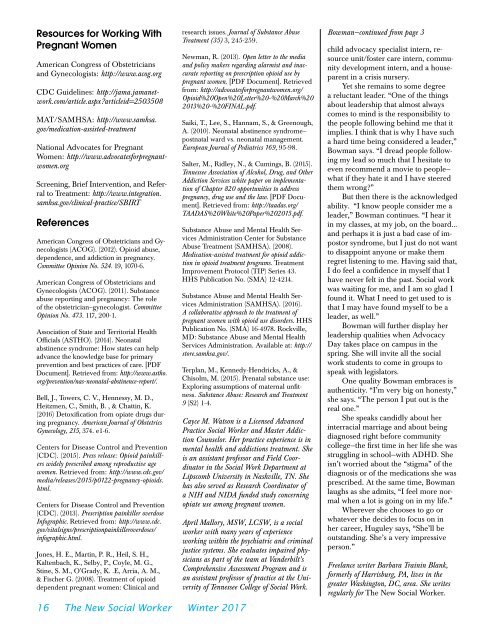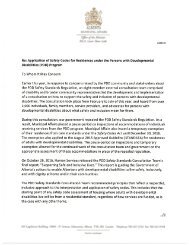In This Issue
click
click
Create successful ePaper yourself
Turn your PDF publications into a flip-book with our unique Google optimized e-Paper software.
Resources for Working With<br />
Pregnant Women<br />
American Congress of Obstetricians<br />
and Gynecologists: http://www.acog.org<br />
CDC Guidelines: http://jama.jamanetwork.com/article.aspx?articleid=2503508<br />
MAT/SAMHSA: http://www.samhsa.<br />
gov/medication-assisted-treatment<br />
National Advocates for Pregnant<br />
Women: http://www.advocatesforpregnantwomen.org<br />
Screening, Brief <strong>In</strong>tervention, and Referral<br />
to Treatment: http://www.integration.<br />
samhsa.gov/clinical-practice/SBIRT<br />
References<br />
American Congress of Obstetricians and Gynecologists<br />
(ACOG). (2012). Opioid abuse,<br />
dependence, and addiction in pregnancy.<br />
Committee Opinion No. 524. 19, 1070-6.<br />
American Congress of Obstetricians and<br />
Gynecologists (ACOG). (2011). Substance<br />
abuse reporting and pregnancy: The role<br />
of the obstetrician–gynecologist. Committee<br />
Opinion No. 473. 117, 200-1.<br />
Association of State and Territorial Health<br />
Officials (ASTHO). (2014). Neonatal<br />
abstinence syndrome: How states can help<br />
advance the knowledge base for primary<br />
prevention and best practices of care. [PDF<br />
Document]. Retrieved from: http://www.astho.<br />
org/prevention/nas-neonatal-abstinence-report/.<br />
Bell, J., Towers, C. V., Hennessy, M. D.,<br />
Heitzmen, C., Smith, B. , & Chattin, K.<br />
(2016) Detoxification from opiate drugs during<br />
pregnancy. American Journal of Obstetrics<br />
Gynecology, 215, 374. e1-6.<br />
Centers for Disease Control and Prevention<br />
(CDC). (2015). Press release: Opioid painkillers<br />
widely prescribed among reproductive age<br />
women. Retrieved from: http://www.cdc.gov/<br />
media/releases/2015/p0122-pregnancy-opioids.<br />
html.<br />
Centers for Disease Control and Prevention<br />
(CDC). (2013). Prescription painkiller overdose<br />
<strong>In</strong>fographic. Retrieved from: http://www.cdc.<br />
gov/vitalsigns/prescriptionpainkilleroverdoses/<br />
infographic.html.<br />
Jones, H. E., Martin, P. R., Heil, S. H.,<br />
Kaltenbach, K., Selby, P., Coyle, M. G.,<br />
Stine, S. M., O'Grady, K. .E, Arria, A. M.,<br />
& Fischer G. (2008). Treatment of opioid<br />
dependent pregnant women: Clinical and<br />
research issues. Journal of Substance Abuse<br />
Treatment (35) 3, 245-259.<br />
16 The New Social Worker Winter 2017<br />
Newman, R. (2013). Open letter to the media<br />
and policy makers regarding alarmist and inaccurate<br />
reporting on prescription opioid use by<br />
pregnant women. [PDF Document]. Retrieved<br />
from: http://advocatesforpregnantwomen.org/<br />
Opioid%20Open%20Letter%20-%20March%20<br />
2013%20-%20FINAL.pdf.<br />
Saiki, T., Lee, S., Hannam, S., & Greenough,<br />
A. (2010). Neonatal abstinence syndrome–<br />
postnatal ward vs. neonatal management.<br />
European Journal of Pediatrics 169, 95-98.<br />
Salter, M., Ridley, N., & Cumings, B. (2015).<br />
Tennessee Association of Alcohol, Drug, and Other<br />
Addiction Services white paper on implementation<br />
of Chapter 820 opportunities to address<br />
pregnancy, drug use and the law. [PDF Document].<br />
Retrieved from: http://taadas.org/<br />
TAADAS%20White%20Paper%202015.pdf.<br />
Substance Abuse and Mental Health Services<br />
Administration Center for Substance<br />
Abuse Treatment (SAMHSA). (2008).<br />
Medication-assisted treatment for opioid addiction<br />
in opioid treatment programs. Treatment<br />
Improvement Protocol (TIP) Series 43.<br />
HHS Publication No. (SMA) 12-4214.<br />
Substance Abuse and Mental Health Services<br />
Administration (SAMHSA). (2016).<br />
A collaborative approach to the treatment of<br />
pregnant women with opioid use disorders. HHS<br />
Publication No. (SMA) 16-4978. Rockville,<br />
MD: Substance Abuse and Mental Health<br />
Services Administration. Available at: http://<br />
store.samhsa.gov/.<br />
Terplan, M., Kennedy-Hendricks, A., &<br />
Chisolm, M. (2015). Prenatal substance use:<br />
Exploring assumptions of maternal unfitness.<br />
Substance Abuse: Research and Treatment<br />
9 (S2) 1-4.<br />
Cayce M. Watson is a Licensed Advanced<br />
Practice Social Worker and Master Addiction<br />
Counselor. Her practice experience is in<br />
mental health and addictions treatment. She<br />
is an assistant professor and Field Coordinator<br />
in the Social Work Department at<br />
Lipscomb University in Nashville, TN. She<br />
has also served as Research Coordinator of<br />
a NIH and NIDA funded study concerning<br />
opiate use among pregnant women.<br />
April Mallory, MSW, LCSW, is a social<br />
worker with many years of experience<br />
working within the psychiatric and criminal<br />
justice systems. She evaluates impaired physicians<br />
as part of the team at Vanderbilt’s<br />
Comprehensive Assessment Program and is<br />
an assistant professor of practice at the University<br />
of Tennessee College of Social Work.<br />
Bowman—continued from page 3<br />
child advocacy specialist intern, resource<br />
unit/foster care intern, community<br />
development intern, and a houseparent<br />
in a crisis nursery.<br />
Yet she remains to some degree<br />
a reluctant leader. “One of the things<br />
about leadership that almost always<br />
comes to mind is the responsibility to<br />
the people following behind me that it<br />
implies. I think that is why I have such<br />
a hard time being considered a leader,”<br />
Bowman says. “I dread people following<br />
my lead so much that I hesitate to<br />
even recommend a movie to people—<br />
what if they hate it and I have steered<br />
them wrong?”<br />
But then there is the acknowledged<br />
ability. “I know people consider me a<br />
leader,” Bowman continues. “I hear it<br />
in my classes, at my job, on the board...<br />
and perhaps it is just a bad case of impostor<br />
syndrome, but I just do not want<br />
to disappoint anyone or make them<br />
regret listening to me. Having said that,<br />
I do feel a confidence in myself that I<br />
have never felt in the past. Social work<br />
was waiting for me, and I am so glad I<br />
found it. What I need to get used to is<br />
that I may have found myself to be a<br />
leader, as well.”<br />
Bowman will further display her<br />
leadership qualities when Advocacy<br />
Day takes place on campus in the<br />
spring. She will invite all the social<br />
work students to come in groups to<br />
speak with legislators.<br />
One quality Bowman embraces is<br />
authenticity. “I’m very big on honesty,”<br />
she says. “The person I put out is the<br />
real one.”<br />
She speaks candidly about her<br />
interracial marriage and about being<br />
diagnosed right before community<br />
college—the first time in her life she was<br />
struggling in school—with ADHD. She<br />
isn’t worried about the “stigma” of the<br />
diagnosis or of the medications she was<br />
prescribed. At the same time, Bowman<br />
laughs as she admits, “I feel more normal<br />
when a lot is going on in my life.”<br />
Wherever she chooses to go or<br />
whatever she decides to focus on in<br />
her career, Huguley says, “She’ll be<br />
outstanding. She’s a very impressive<br />
person.”<br />
Freelance writer Barbara Trainin Blank,<br />
formerly of Harrisburg, PA, lives in the<br />
greater Washington, DC, area. She writes<br />
regularly for The New Social Worker.




